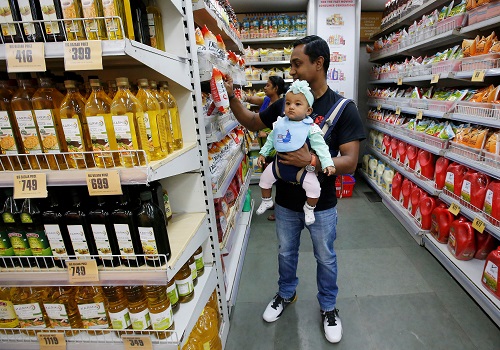Gold trading range for the day is 61995-62735 - Kedia Advisory

Follow us Now on Telegram ! Get daily 10 - 12 important updates on Business, Finance and Investment. Join our Telegram Channel
Gold:
Gold prices experienced a notable uptick, closing 0.42% higher at 62367, propelled by escalating geopolitical tensions and market uncertainties. The drone attack on US bases near north-eastern Jordan heightened demand for the precious metal as a safe-haven asset. The mounting global uncertainties were further compounded by a moderate increase in the US Core Personal Consumption Expenditures (PCE) data for December, which tempered the inflation outlook. The soft core PCE price index report, with monthly growth meeting expectations at 0.2%, failed to lift expectations of an imminent rate cut from the Federal Reserve. Investor focus now shifts to the upcoming Federal Reserve interest rate decision, Institute of Supply Management (ISM) Manufacturing PMI, and Nonfarm Payrolls (NFP) report for December. While the Fed is expected to maintain interest rates within the 5.25-5.50% range, market participants are keenly awaiting guidance on future rate-cutting prospects. The potential for a dovish decision in March or May is being closely monitored, with investors seeking clues from policymakers. Technically, the market exhibits signs of fresh buying, as evidenced by an 11.05% increase in open interest to 13569, coupled with a price surge of 261 rupees. Support for gold is established at 62180, with a possible test of 61995 if breached, while resistance is anticipated at 62550, and a breakthrough could lead to a test of 62735.
Trading Ideas:
* Gold trading range for the day is 61995-62735.
* Gold price delivers strong upside move as geopolitical tensions deepen.
* Monthly core PCE grew by 0.2% as expected while annual underlying inflation data decelerated to 2.9% against expectations of 3.0%
* Fed policy, labor market and Manufacturing PMI data for December will remain in the spotlight.
Silver:
Silver posted a gain of 0.84%, settling at 72377, driven by safe-haven buying following a terrorist strike in Jordan that resulted in the death of three U.S. soldiers. The European Central Bank (ECB) announced its decision to keep interest rates steady and committed to maintaining restrictive rates for as long as necessary to combat inflation, despite potential recession risks. In the United States, the Bureau of Economic Analysis (BEA) reported stronger-than-expected economic growth, with the economy expanding at a pace of 3.3%, surpassing the market's 2% anticipation. The Gross Domestic Product (GDP) for the July-September quarter rose significantly by 4.9%, signaling resilience in the U.S. economy. This upbeat data challenges the consensus argument for early interest rate cuts by the Federal Reserve (Fed), with policymakers likely deeming rate cuts from March as "premature." The risk aversion sentiment heightened after a drone strike in Jordan, resulting in the death of three U.S. soldiers. President Biden indicated that the U.S. would respond. Silver prices were further supported by the current decline in U.S. 10-year treasury yields ahead of the Federal Reserve's policy meeting scheduled for this week. Technically, the market is witnessing short-covering, marked by a 12.09% drop in open interest to settle at 23368, while prices rose by 604 rupees. Silver is finding support at 71870, and a breach below this level could test 71365. On the upside, resistance is likely at 72715, and a move above could lead to prices testing 73055.
Trading Ideas:
# Silver trading range for the day is 71365-73055.
# Silver gains as geopolitical tensions in the Middle East deteriorate.
# Prices are boosted by the current decline in US 10-year treasury yields ahead of Fed policy meeting
# The US economy grew strongly by 3.3% while investors projected GDP expansion by 2%.
Crude oil:
Crude oil prices closed 0.28% higher at 6399, driven by a confluence of factors contributing to market optimism. The recent stimulus measures announced by China, particularly the reduction in the reserve requirement for banks, injected liquidity into the market and bolstered expectations of an economic recovery. This anticipated recovery is a key driver behind the increased demand for crude oil. Further supporting the bullish sentiment was the larger-than-expected inventory draw in the U.S. Official data from the U.S. Energy Information Administration revealed a significant decline of 9.2 million barrels in crude oil inventories for the week ended January 19, surpassing market expectations of a 2.2 million barrel draw. The unexpected draw follows a 2.5 million barrel reduction in the previous week, as reported by the American Petroleum Institute. The International Energy Agency's decision to expedite the publication of its first 2025 oil demand forecast by two or three months to April reflects a proactive response to evolving market dynamics. This move aligns with OPEC's decision to advance its forecast by six months, indicating the industry's focus on adapting to changing conditions. Technically, the market shows signs of short-covering, evidenced by a 22.79% drop in open interest to 8657, coupled with a modest price increase of 18 rupees. Crude oil has established support at 6335, with potential downside to 6272 if breached. On the upside, resistance is anticipated at 6495, and a breakthrough could lead to a test of 6592.
Trading Ideas:
* Crudeoil trading range for the day is 6272-6592.
* Crude oil surged due to China’s stimulus and larger-than-expected US inventory draw
* China reduced the reserve requirement for banks, allowing for a liquidity infusion to support economic recovery.
* EIA reported a decline of 9.2 million barrels in crude oil inventories, larger than the expected decline of 2.2 million barrels.
Natural gas:
Natural gas prices experienced a decline of -4.38%, settling at 174.5, driven by forecasts of warmer-than-normal weather persisting through at least early February. Additionally, the slow return of U.S. liquefied natural gas (LNG) export plants to full service after last week's Arctic freeze contributed to the downward pressure on prices. Despite forecasts indicating higher demand in the upcoming week and the gradual recovery of output from the extreme cold witnessed last week, natural gas prices fell. The recent extreme cold spell led to a surge in gas demand, resulting in a daily record high and a significant reduction in both U.S. gas output and LNG feedgas to a one-year low. The U.S. Energy Information Administration (EIA) reported an extraordinary withdrawal of 326 billion cubic feet (bcf) of gas from storage during the week ending January 19, primarily due to the impact of last week's severe cold. This withdrawal was notably larger than the usual figures and marked the most substantial weekly reduction since 2021, with the all-time record withdrawal occurring in January 2018. Technically, the market is witnessing fresh selling, with a notable 18.87% increase in open interest to settle at 60701, while prices declined by -8 rupees. Natural gas finds support at 171.3, and a breach below this level could test 168. On the upside, resistance is anticipated at 179.7, and a move above could lead to prices testing 184.8. Traders should closely monitor weather forecasts, LNG export developments, and storage data for potential market shifts.
Trading Ideas:
* Naturalgas trading range for the day is 168-184.8.
* Natural gas dropped due to warmer weather forecasts and slow recovery of LNG export plants.
* Output of natural gas has been slow to return after wells and equipment froze during the recent Arctic freeze.
* Extreme cold last week led to record high gas demand and decreased gas output and LNG feedgas.
Copper:
Copper prices closed 0.34% higher at 731.95, buoyed by optimism stemming from policy support in China, the world's leading consumer of the metal. The Chinese central bank's significant cut to bank reserves, injecting approximately $140 billion into the banking system, signaled strong support for the country's fragile economy. Additionally, reports of a 2 trillion yuan stabilisation fund aimed at purchasing shares onshore through the Hong Kong exchange link contributed to positive market sentiment. However, the potential for further price rallies faced constraints due to slowing growth in physical consumption of nonferrous metals and mixed macroeconomic data globally. Despite these challenges, concerns about long-term copper supply failing to match its pivotal role in electrification continued to support prices. The International Copper Study Group (ICSG) reported a deficit of 119,000 metric tons in the global refined copper market for November, up from 48,000 metric tons in October. World refined copper output in November was 2.26 million metric tons, with consumption at 2.38 million metric tons. From a technical standpoint, the market exhibited signs of fresh buying, with a 2.18% increase in open interest to 4643 and a price uptick of 2.45 rupees. Copper finds support at 728.1, and a breach could lead to a test of 724.2. On the upside, resistance is anticipated at 734.2, with a potential breakthrough paving the way for testing 736.4.
Trading Ideas:
# Copper trading range for the day is 724.2-736.4.
# Copper gains due to optimism on policy support in China.
# China's central bank announced a deep cut to bank reserves, injecting $140 billion into the banking system.
# The global refined copper market showed a deficit of 119,000 metric tons in November.
Zinc:
Zinc prices experienced a decline of -0.42%, settling at 227.15, influenced by pressure from a stable dollar ahead of U.S. economic data. Additionally, a subdued demand outlook from China, the top consumer of zinc, weighed on market sentiment. However, the downside was limited as the market found support from a cut in bank reserves in China, injecting approximately $140 billion into the banking system. China's central bank announced a significant reduction in the amount of cash banks are required to hold as reserves, aiming to free up liquidity. The International Lead and Zinc Study Group (ILZSG) data indicated that the global zinc market shifted into a deficit of 71,600 metric tons in November 2023, compared to a deficit of 62,500 tons in October. China's refined zinc output in December 2023 rose to 590,900 metric tons, reflecting a 2.05% monthly increase and a 12.38% year-on-year growth. The cumulative refined zinc output from January to December reached 6.622 million metric tons, a 10.77% increase from the previous year. Additionally, zinc alloy production in China increased to 102,900 metric tons in December, showing a monthly rise of 9,600 metric tons. Technically, the market witnessed long liquidation with a -1.73% drop in open interest to settle at 3288, while prices decreased by -0.95 rupees. Zinc finds support at 226.2, and a breach below this level could test 225.2, whereas resistance is expected at 228.2, with a move above potentially leading to prices testing 229.2.
Trading Ideas:
# Zinc trading range for the day is 225.2-229.2.
# Zinc dropped as subdued demand outlook from China weighed on sentiment.
# China's cabinet pledges to stabilize market confidence
# Global zinc market deficit increased in November 2023
Aluminium:
Aluminium prices closed 0.54% higher at 204.15, driven by optimism surrounding Chinese policy support following a seasonal lull. China's central bank governor, Pan Gongsheng, announced a 50 basis points reduction in the amount of cash that banks must hold as reserves starting February 5, marking the first such move in the new year. Additionally, the central bank plans to cut re-lending and re-discount interest rates by 25 basis points for the rural sector and small firms, effective January 25, as part of efforts to address multiple economic challenges. The World Bureau of Metal Statistics (WBMS) reported a global primary aluminum production of 5.8613 million tons in November, with consumption at 5.9714 million tons, resulting in a supply shortage of approximately 80,000 tons. Despite a surplus of around 600,000 tons in the first 11 months of the previous year, December witnessed a 2.1% year-on-year increase in global primary aluminum output to 6.041 million tonnes, according to the International Aluminium Institute (IAI). China's notable 28% increase in aluminium imports in 2023, as indicated by customs data, reflects robust demand and higher prices in the world's largest consumer market for the metal. Technically, the market showed signs of short-covering, evidenced by a 4.11% drop in open interest to 3712, coupled with a modest price increase of 1.1 rupees. Aluminium finds support at 203.1, and a breach could lead to a test of 202, while resistance is anticipated at 205, with a potential breakthrough paving the way for testing 205.8.
Trading Ideas:
* Aluminium trading range for the day is 202-205.8.
* Aluminium seen supported by Chinese policy support
* China's imports of aluminum increased by 28% in 2023
* China's central bank injects $140 billion into banking system
Cotton candy:
Cotton Candy prices observed a decline of -0.66%, settling at 57620, influenced by the rise in overseas prices due to a drawdown in unsold inventories and a weaker U.S. dollar. The global cotton market faced adjustments in consumption estimates for the 2023/24 season, with reductions for India, Indonesia, Pakistan, Uzbekistan, and Turkey, resulting in a forecasted decrease of 1.3 million bales. Despite higher world production, led by increased cotton crops in China and Argentina, lower consumption and higher beginning stocks contributed to a 2.0 million bale increase in 2023/24 ending stocks. On the domestic front, the Cotton Association of India (CAI) maintained its estimates for domestic cotton consumption at 311 lakh bales for the 2023-24 season. The pressing estimates for the same period were retained at 294.10 lakh bales. The overall cotton supply till the end of the 2023-24 season was estimated at 345 lakh bales. Brazil recorded historic high cotton production in the 2022-23 season, driven by expanded cultivation and productivity. However, global cotton prices faced challenges due to sluggish demand, leading to increased inventories worldwide. In terms of technical analysis, the market is currently under fresh selling pressure, with open interest increasing by 8.66% to settle at 276. Cotton Candy finds support at 57380, and a breach below this level could test 57140. Resistance is observed at 57880, and a move above this level might lead to prices testing 58140.
Trading Ideas:
* Cottoncandy trading range for the day is 57140-58140.
* Cotton gains amid rise in overseas prices supported by a drawdown in unsold inventories
* World 2023/24 ending stocks are forecast 2.0 million bales higher this month driven by higher beginning stocks.
* World production is 260,000 bales higher with China’s crop up 500,000 bales and Argentina’s production higher as well
* In Rajkot, a major spot market, the price ended at 26568.85 Rupees dropped by -0.49 percent.
Turmeric:
Turmeric prices experienced a significant decline of -5.99%, settling at 15058, driven by slower buying activities in anticipation of stock releases ahead of the commencement of new crops. The pressure on prices was further fueled by favorable weather conditions contributing to improved crop conditions. However, the downside was limited due to weaker production prospects and tighter stocks in the market, with support evident for improved export opportunities. Concerns among Maharashtra farmers regarding the location of PM Modi's Turmeric Board in Telangana added to market dynamics. Crop conditions are reported to be satisfactory, and the harvest is expected during January to March. Despite current lower buying activity and decreasing supplies, the expectation is for price stability. The demand for turmeric has seen an increase in both developed and emerging nations, leading to a 25% rise in exports. Turmeric exports during April-November 2023 dropped by 1.07% to 1,10,745.38 tonnes compared to the same period in 2022. In November 2023, around 8,582.44 tonnes were exported, marking a 15.34% decline from October and a 30.78% drop from November 2022. Imports during April-November 2023 decreased by 29.50%, reaching 9,384.42 tonnes, and in November 2023, 1,305.24 tonnes were imported, down by 48.82% from October and 12.99% from November 2022. Technically, the market is under long liquidation, with a 6.01% drop in open interest to settle at 12345. Turmeric is finding support at 14662, and a breach below this level could test 14264. Resistance is observed at 15854, and a move above this level might lead to prices testing 16648.
Trading Ideas:
* Turmeric trading range for the day is 14264-16648.
* Turmeric dropped as buying activities has been slower
* Pressure also seen amid expectation of release of stocks ahead of commencement of new crops
* Prices also dropped amid Improved crop condition due to favorable weather condition.
* In Nizamabad, a major spot market, the price ended at 13895.4 Rupees gained by 0.48 percent.
Jeera:
Jeera prices tumbled by -5.32%, settling at 26240, driven by higher production prospects in key cultivating states of Gujarat and Rajasthan. The current rabi season witnessed a surge in jeera acreage to a four-year high, with farmers expanding cultivation due to the record prices observed in the last marketing season. In Gujarat, jeera cultivation covered 5.60 lakh hectares, a remarkable 160% increase from the previous year, surpassing the normal acreage of 3.5 lakh hectares. Rajasthan also saw a 25% rise in jeera cultivation, reaching 6.90 lakh hectares compared to 5.50 lakh hectares in the previous year. Despite expectations of a potentially bumper crop in India, global demand for Indian jeera declined, with buyers preferring other destinations like Syria and Turkey due to the higher prices in India. Challenges such as lower water availability, fewer cold days, and concerns about fusarium wilt attacks on crops are impacting the production outlook. Jeera exports during April-November 2023 dropped by 33.10%, reaching 84,467.16 tonnes, while imports plummeted by 1,134.63% to 16,330.89 tonnes. In November 2023, jeera exports rose by 30.04% compared to October but declined by 22.89% compared to November 2022. Jeera imports in November 2023 dropped by 81.18% compared to October but increased significantly by 1,426.38% compared to November 2022. Technically, the market is under fresh selling pressure, with open interest increasing by 5.68% to settle at 1953. Jeera is finding support at 25600, and a breach below this level could test 24950. Resistance is observed at 27400, and a move above this level might lead to prices testing 28550.
Trading Ideas:
* Jeera trading range for the day is 24950-28550.
* Jeera prices dropped due to higher production prospects
* In Gujarat, Cumin sowing witnessed very strong growth by nearly 103% with 530,030.00 hectares against sown area of 2022
* Stockists are showing interest in buying on recent downfall in prices triggering short covering.
* In Unjha, a major spot market, the price ended at 32031.05 Rupees gained by 0.29 percent.
Views express by all participants are for information & academic purpose only. Kindly read disclaimer before referring below views. Click Here For Disclaimer












 320-x-100_uti_gold.jpg" alt="Advertisement">
320-x-100_uti_gold.jpg" alt="Advertisement">











